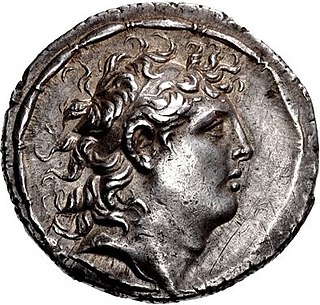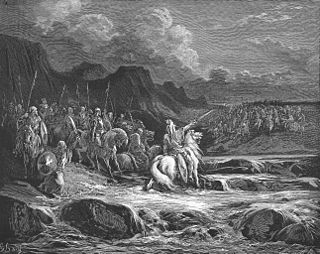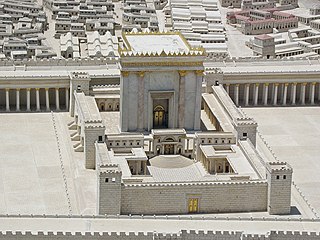Related Research Articles
This article concerns the period 169 BC – 160 BC.
Cocytus or Kokytos is the river of wailing in the underworld in Greek mythology. Cocytus flows into the river Acheron, on the other side of which lies Hades, the underworld, the mythological abode of the dead. There are five rivers encircling Hades: the Styx, Phlegethon, Lethe, Acheron and Cocytus.

Diodotus Tryphon, nicknamed "The Magnificent" was a Greek king of the Seleucid Empire. Initially an official under King Alexander I Balas, he led a revolt against Alexander's successor Demetrius II Nicator in 144 BC. He rapidly gained control of most of Syria and the Levant. At first, he acted as regent and tutor for Alexander's infant son Antiochus VI Dionysus, but after the death of his charge in 142/141 BC, Diodotus declared himself king. He took the royal name Tryphon Autocrator and distanced himself from the Seleucid dynasty. For a period between 139 and 138, he was the sole ruler of the Seleucid empire. However, in 138 BC Demetrius II's brother Antiochus VII Sidetes invaded Syria and brought his rule to an end.

The Maccabees, also spelled Machabees, were a group of Jewish rebel warriors who took control of Judea, which at the time was part of the Seleucid Empire. They founded the Hasmonean dynasty, which ruled from 167 to 37 BCE, being a fully independent kingdom from 104 to 63 BCE. They reasserted the Jewish religion, expanded the boundaries of Judea by conquest, and reduced the influence of Hellenism and Hellenistic Judaism.

The Hasmonean dynasty was a ruling dynasty of Judea and surrounding regions during the Hellenistic times of the Second Temple period, from c. 140 BCE to 37 BCE. Between c. 140 and c. 116 BCE the dynasty ruled Judea semi-autonomously in the Seleucid Empire, and from roughly 110 BCE, with the empire disintegrating, Judea gained further autonomy and expanded into the neighboring regions of Perea, Samaria, Idumea, Galilee, and Iturea. The Hasmonean rulers took the Greek title basileus ("king") as the kingdom became a regional power for several decades. Forces of the Roman Republic intervened in the Hasmonean Civil War in 63 BCE and made it into a client state, marking the decline of Hasmonean dynasty; Herod the Great displaced the last reigning Hasmonean client-ruler in 37 BCE.

Simon Thassi was the second son of Mattathias and thus a member of the Hasmonean family.
1 Maccabees, also known as the First Book of Maccabees, First Maccabees, and abbreviated as 1 Macc., is a deuterocanonical book which details the history of the Maccabean Revolt against the Seleucid Empire as well as the founding and earliest history of the independent Hasmonean kingdom. It describes the promulgation of decrees forbidding traditional Jewish practices by King Antiochus IV Epiphanes and the formation of a rebellion against him by Mattathias of the Hasmonean family and his five sons. Mattathias's son Judas Maccabeus takes over the revolt and the rebels as a group are called the Maccabees; the book chronicles in detail the successes and setbacks of the rebellion. While Judas is eventually killed in battle, the Maccabees eventually achieve autonomy and then independence for Judea under the leadership of the Hasmonean family. Judas's brother Simon Thassi is declared High Priest by will of the Jewish people. The time period described is from around 170 BC to 134 BC.

John Hyrcanus was a Hasmonean (Maccabean) leader and Jewish High Priest of Israel of the 2nd century BCE. In rabbinic literature he is often referred to as Yoḥanan Cohen Gadol, "John the High Priest".

The Battle of Elasa was fought in April 160 BCE during the Maccabean Revolt between Judean rebels led by Judas Maccabeus and an army of the Seleucid Empire under the command of Bacchides. The battle resulted in the triumph of the Greek Syrian forces, the defeat of the Maccabees, and the death of Judas Maccabeus.

John Hyrcanus II, a member of the Hasmonean dynasty, was for a long time the Jewish High Priest in the 1st century BCE. He was also briefly King of Judea 67–66 BCE and then the ethnarch (ruler) of Judea, probably over the period 47–40 BCE.

Jonathan Apphus was one of the sons of Mattathias and the leader of the Hasmonean dynasty of Judea from 161 to 143 BCE.

Mattathias ben Johanan was a Kohen who helped spark the Maccabean Revolt against the Hellenistic Seleucid Empire. Mattathias's story is related in the deuterocanonical book of 1 Maccabees and in the writings of Josephus. Mattathias is accorded a central role in the story of Hanukkah and, as a result, is named in the Al HaNissim prayer Jews add to the Birkat Hamazon and the Amidah during the festival's eight days.
The Battle of Adasa was fought during the Maccabean revolt on the 13th of the month Adar, 161 BC at Adasa, near Beth-horon. It was a battle between the rebel Maccabees of Judas Maccabeus and the Seleucid Empire, whose army was led by Nicanor. The Maccabees won the battle after killing Nicanor early in the fighting. The battle came after a period of political maneuvering over several months where the peace deal established a year earlier by Lysias was tested by the new High Priest Alcimus, the new military governor Nicanor, and the Maccabee leader Judas Maccabeus.
Bacchides was a Syrian-Greek general and governor (strategos) and friend and advisor (philoi) of King Demetrius I Soter of the Seleucid Empire. The Seleucid Empire was one of the Greek successor states (diadochi) founded after the conquests of Alexander the Great, and was centered in Syria and Babylonia in the Hellenistic era.
Nicanor was a Syrian-Greek general (strategos) that served the Seleucid Empire during the reigns of kings Antiochus IV Epiphanes and Demetrius I Soter. He served during the Maccabean Revolt in Judea, then part of the Seleucid Empire, and served for a time as governor in Jerusalem. Relations between the government and the Jewish rebels eventually turned sufficiently hostile that he threatened the priests at the Second Temple and led an army to find and defeat Judas Maccabeus's followers, but he and his army were defeated at the Battle of Adasa. Nicanor was killed, his corpse was desecrated, his head and right hand hung for public display back in Jerusalem, and a new festival was declared to celebrate his defeat.
The Roman–Jewish Treaty was an agreement made between Judas Maccabeus and the Roman Republic according to the book 1 Maccabees and Josephus's Jewish Antiquities. It took place around 161 BCE and was the first recorded contract between Judea and Ancient Rome. The Romans apparently extended an offer of aid to the Judean rebel side of the Maccabean Revolt. It does not appear the treaty ever resulted in direct action by the Romans in support of the Hasmoneans, but it may have deterred the Seleucid Empire, the regional power in the era, from taking more extreme measures against Judea.

The Maccabean Revolt was a Jewish rebellion led by the Maccabees against the Seleucid Empire and against Hellenistic influence on Jewish life. The main phase of the revolt lasted from 167 to 160 BCE and ended with the Seleucids in control of Judea, but conflict between the Maccabees, Hellenized Jews, and the Seleucids continued until 134 BCE, with the Maccabees eventually attaining independence.

During the Maccabean Revolt against the Seleucid Empire, there were a series of campaigns in 163 BC in regions outlying Judea - Ammon, Gilead, Galilee, Idumea, and Judea's coastal plain, a wider region usually referred to as either Palestine or Eretz Israel. The Maccabee rebels fought multiple enemies: Seleucid garrisons and hired mercenaries under a commander named Timothy of Ammon, non-Jewish inhabitants hostile to the Maccabees and their Jewish neighbors, and possibly the Tobiad Jews, a clan that generally favored the ruling Seleucid government. During 163 BC, the main Seleucid armies composed of Greeks were elsewhere, so the Maccabees were free to expand their influence against their neighbors.

The Second Temple period in Jewish history began with the end of the Babylonian captivity and the Persian conquest of the Babylonian Empire in 539 BCE. A new temple to replace the destroyed Solomon's Temple was built in Jerusalem by the returnees, and the Second Temple was finished around 516 BCE. Second Temple Judaism was centered around the religious leadership of the Second Temple, and lasted for six centuries. The Persians were largely tolerant of Judaism. Persian rule lasted for two centuries, but came to an end with the conquests of Macedonia under Alexander the Great in 332 BCE. Judea and the Eastern Mediterranean region came under Greek influence during the resulting Hellenistic period; Hellenistic Judaism blended both Greek and Jewish traditions. Judea was ruled in this period first by the Ptolemaic Kingdom and then by the Seleucid Empire, Greek states formed after the breakup of Alexander's Macedonian empire. The Maccabean Revolt of 167–142 BCE was initially a fight for Judean autonomy against a suppression of traditional Judaism by Seleucid King Antiochus IV, and later sought outright independence from Greek rule. The revolt's success brought about the formation of an independent Hasmonean kingdom of Judea, named for the family which had led the Jewish resistance.
References
- ↑ 1 Maccabees 16:11–22
- 1 2 Schwartz, Daniel R. (2022). 1 Maccabees: A New Translation with Introduction and Commentary. The Anchor Yale Bible. Vol. 41B. New Haven & London: Yale University Press. Murder of Simon and his Two Sons; John Succeeds Him (16:11-24). doi:10.2307/j.ctv2t5xh30. ISBN 978-0-300-15993-6.
- ↑ Grainger, John D. (2012). The Wars of the Maccabees. Casemate Publishers. pp. 137–140. ISBN 9781781599464.
- ↑ Schürer, Emil (1896) [1890]. A History of the Jewish People in the Times of Jesus Christ. Translated by MacPherson, John. Hendrickson Publishers. pp. 271–274. ISBN 1565630491 . Retrieved October 8, 2021.
- ↑ Dianne Bergant (1992). The Collegeville Bible Commentary: Old Testament. Liturgical Press. p. 394. ISBN 978-0-8146-2210-0.
- ↑ Alighieri, Dante (1949) [14th-century]. The Comedy of Dante Alighieri the Florentine: Hell. Translated by Sayers, Dorothy. Canto XXXIII translator notes, p. 282.